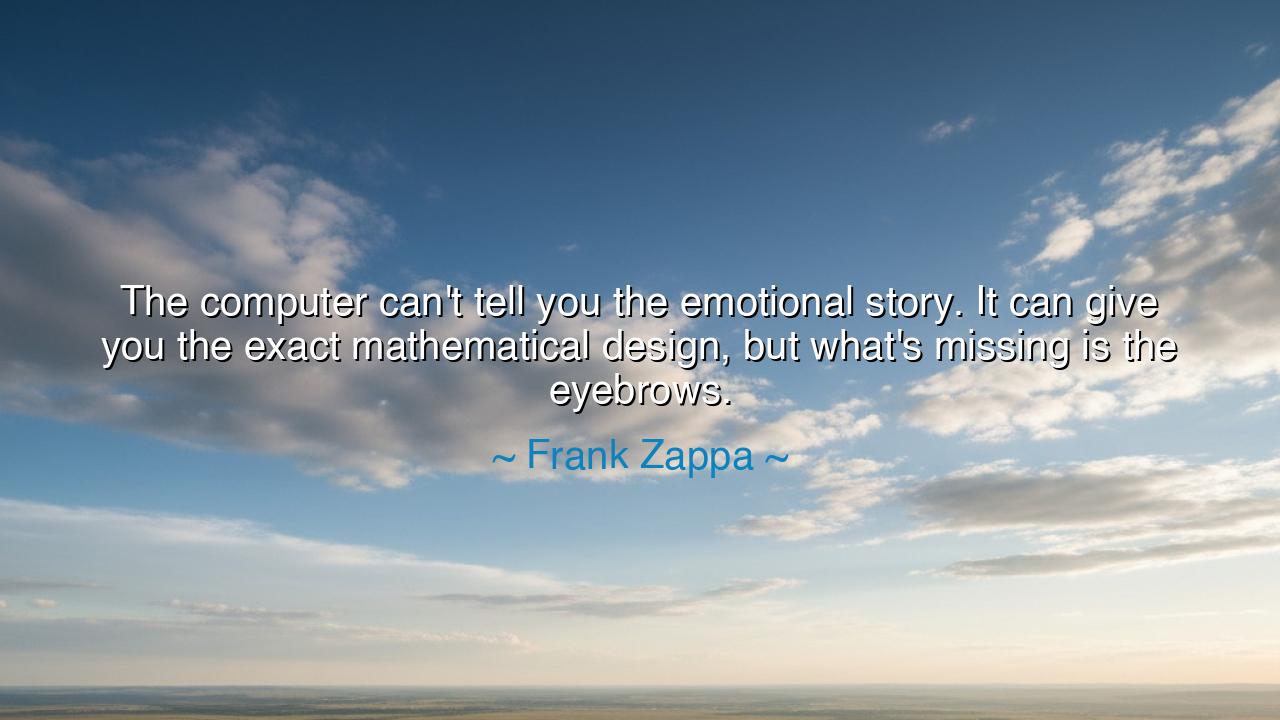
The computer can't tell you the emotional story. It can give you
The computer can't tell you the emotional story. It can give you the exact mathematical design, but what's missing is the eyebrows.






“The computer can’t tell you the emotional story. It can give you the exact mathematical design, but what’s missing is the eyebrows.” — Frank Zappa
Thus spoke Frank Zappa, the maverick musician and prophet of creative rebellion, in an age when machines had begun to whisper promises of perfection. In his words lies not merely a comment on technology, but a profound meditation on the nature of art, emotion, and humanity. When he says, “The computer can’t tell you the emotional story… what’s missing is the eyebrows,” he points to the eternal divide between calculation and expression, between precision and soul. For the computer may measure sound and color to infinite accuracy, but it cannot measure longing. It may compose the structure of a song, but it cannot feel the ache that gives the song its life.
Zappa, a man of both intellect and fire, lived in the borderlands between order and chaos — a place where music, mathematics, and madness met. He embraced innovation, yet never surrendered to it. He saw that technology, wondrous as it was, could never replace the pulse of the living heart. The mathematical design might be perfect — the chords flawless, the rhythm precise — yet something essential would always be missing: the tiny, imperfect gestures that make art human. The eyebrows, as Zappa called them, are those subtle inflections of feeling — the breath before the note, the tremor in the voice, the laughter hidden in a brushstroke. They are the signs of spirit that no machine can truly recreate, for they are born from the soul’s trembling.
The ancients, too, understood this truth. When the sculptor Phidias carved the statues of the gods, he was said to breathe life into marble. His figures were not merely anatomically correct — they possessed something divine, an aura beyond measurement. Centuries later, Leonardo da Vinci, that master of art and science alike, wrote that the painter must capture “the motions of the mind.” He could dissect the human body, calculate perspective, and study geometry — yet he knew that the mystery of expression could not be reduced to lines and numbers. The spark of life, that flicker in the eyes, is not drawn by rule but by reverence.
In our own age, where algorithms compose symphonies and machines paint landscapes, Zappa’s warning resounds like a bell through the fog: do not let perfection extinguish personality. The danger of the mechanical mind is not that it creates, but that it tempts us to forget what creation means. For creation is not the replication of beauty; it is the revelation of feeling. A computer may play every note flawlessly, but it will never falter — and it is in faltering that truth is found. The quiver in a singer’s voice, the rough edge of a painter’s stroke, the uneven rhythm of a dancer’s foot — these are the eyebrows that give art its face.
Consider the story of the jazz legend Miles Davis, who once turned his back to the audience and told his musicians, “Don’t play what’s there — play what’s not there.” In those words lies the spirit of Zappa’s warning. Miles knew that music lives not in the notes themselves, but in the spaces between — in the hesitation, the breath, the silence pregnant with emotion. A computer can replicate the sound, but never the silence that means something. The human heart, in its vulnerability and imperfection, gives meaning to what machines can only mimic.
The lesson is this: embrace the tools of your age, but never mistake them for your soul. Use the computer, but do not let it speak for you. Let it measure, but do not let it feel. Whether you are a maker of music, a builder of machines, or a teller of stories, remember that your greatest power lies not in precision but in presence — in the living pulse of your humanity. Do not fear imperfection; it is the sign that something real is breathing through your work.
So, children of the future, heed the wisdom of Frank Zappa: let the machines draw the lines, but let your heart raise the eyebrows. Let your art be flawed, wild, and full of wonder. For only in the trembling hand, the unsteady voice, the unplanned laugh, does life reveal its truth. The computer may craft a melody of logic, but only you can sing the emotional story — the one that reminds the world that though perfection is lifeless, humanity is divine.






AAdministratorAdministrator
Welcome, honored guests. Please leave a comment, we will respond soon